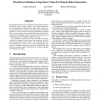Free Online Productivity Tools
i2Speak
i2Symbol
i2OCR
iTex2Img
iWeb2Print
iWeb2Shot
i2Type
iPdf2Split
iPdf2Merge
i2Bopomofo
i2Arabic
i2Style
i2Image
i2PDF
iLatex2Rtf
Sci2ools
113
click to vote
FGR
2004
IEEE
2004
IEEE
Head Pose Estimation Using Stereo Vision For Human-Robot Interaction
In this paper we present a method for estimating a person's head pose with a stereo camera. Our approach focuses on the application of human-robot interaction, where people may be further away from the camera and move freely around in a room. We show that depth information acquired from a stereo camera not only helps improving the accuracy of the pose estimation, but also improves the robustness of the system when the lighting conditions change. The estimation is based on neural networks, which are trained to compute the head pose from grayscale and disparity images of the stereo camera. It can handle pan and tilt rotations from -90 to +90 . Our system doesn't require any manual initialization and doesn't suffer from drift during an image sequence. Moreover the system is capable of real-time processing.
Related Content
| Added | 20 Aug 2010 |
| Updated | 20 Aug 2010 |
| Type | Conference |
| Year | 2004 |
| Where | FGR |
| Authors | Edgar Seemann, Kai Nickel, Rainer Stiefelhagen |
Comments (0)

